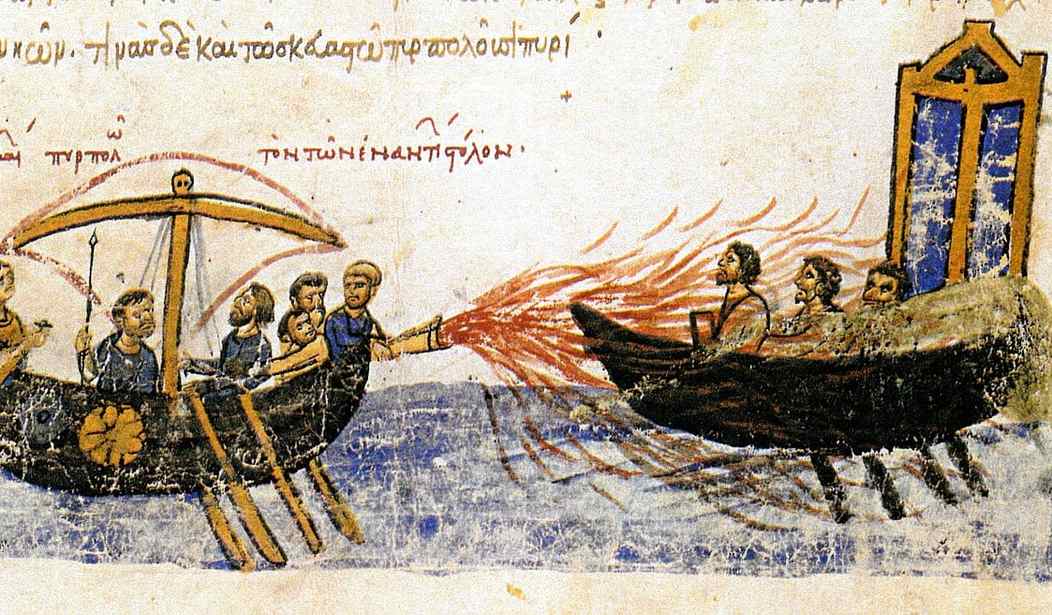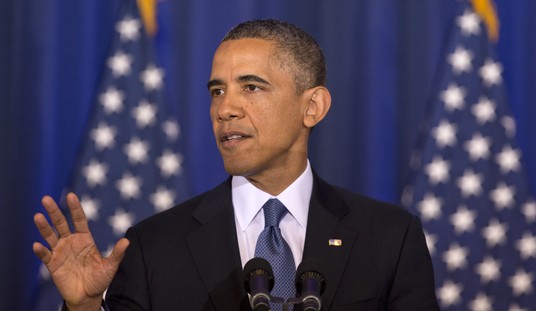Turkey has repeatedly made clear that few things in Islamic history are more glorious than the jihadi conquest of Constantinople in 1453, as underscored by the recent transformation of the heart of Constantinople—the Hagia Sophia, formerly one of Christendom’s greatest cathedrals—into a mosque.
Why Constantinople? Because of all the “infidel” cities of the world, Islam’s prophet Muhammad most desired it—and promised great paradisiacal rewards for whichever Muslim conquered it, for it was the Christian capital of the Eastern Roman Empire. Despite this, and unlike the other major Christian centers which had fallen to the sword of Islam—Alexandria, Antioch, Jerusalem, not to mention nearly two-thirds of Christendom—for centuries Constantinople defied it.
Indeed, today in history, August 15, 718, not only did Constantinople score its greatest victory against Islam, but, as shall be seen, it saved Western civilization. The story is worth recounting:
After several failed sieges, in the year 715, the Umayyad caliphate had concluded that enough was enough: it would vomit forth all it had in one final, all-out effort to conquer the ancient Christian capital. Caliph Suleiman summoned his younger brother, Maslama, and commanded him to lead Islam’s combined forces to Constantinople and “stay there until you conquer it or I recall you.” The young emir embraced the honor: soon “I [will] enter this city knowing that it is the capital of Christianity and its glory; my only purpose in entering it is to uphold Islam and humiliate unbelief.”
At the head of 120,000 jihadis, Maslama crossed into Christian territory and, with “both sword and fire, he put an end to Asia Minor,” wrote a near-contemporary chronicler. On August 15, 717, he began bombarding the city, which was defended by Leo III, formerly a general. Just weeks earlier, and because he was deemed the ablest man, Leo had been consecrated in the Hagia Sophia as the new emperor.
Unable to breach the cyclopean walls of Constantinople, Maslama waited for 1,800 vessels containing an additional 80,000 fighting men to approach through the Bosporus and completely blockade—and thus starve—the city.
Suddenly Leo ordered the ponderous chain that normally guarded the harbor cast aside. Then, “while they [Muslim fleets] hesitated whether they should seize the opportunity . . . the ministers of destruction were at hand.” Leo sent forth the “fire-bearing ships” against the Islamic fleet, which was quickly set “on fire,” writes Theophanes the chronicler: “some of them were cast up burning by the sea walls, others sank to the bottom with their crews, and others were swept down flaming.”
Matters worsened when Maslama received word that the caliph, his brother Suleiman, had died of “indigestion” (by reportedly devouring two baskets of eggs and figs, followed by marrow and sugar for dessert). The new caliph, Omar II, was initially inattentive to the Muslim army’s needs. Maslama stayed and wintered in.
Unfortunately for him, “one of the cruelest winters that anyone could remember” arrived, and, “for one hundred days, snow covered the earth.” All Maslama could do was assure his emaciated, half-frozen men that “Soon! Soon supplies will be here!” But they did not come; worse, warlike nomadic tribesmen known as Bulgars—whence the nation of Bulgaria—accustomed to the terrain and climate began to harry any Muslim detachment that left the starving camp in search of food.
By spring, Muslim reinforcements and provisions finally arrived by land and sea. But the damage was done; frost and famine had taken their toll on the Muslims encamped outside the walls of Constantinople. “Since the Arabs were extremely hungry,” writes Theophanes, “they ate all their dead animals: horses, asses, and camels. Some even say they put dead men and their own dung in pans, kneaded this, and ate it. A plague-like disease descended on them, and destroyed a countless throng.”
Even so, knowing that such a massive force—which had taken years to assemble and had severely taxed the caliphate’s resources—was already at the walls of Islam’s archrival was too much of a temptation for Omar to order a withdrawal. The new caliph also knew that nothing could bolster his credentials as the conquest of that one infidel kingdom that remained a thorn in Islam’s side. Thus, while the Muslim land force recuperated, a new navy, composed of eight hundred ships, was outfitted in the ports of Alexandria and Libya. The fleet arrived under the cover of night and managed to blockade the Bosporus. Having learned the lesson of Greek Fire, the prudent ships kept their distance.
Just as the beginning of the end seemed to have arrived for Constantinople, sudden delivery—and from the least expected source—came: the crews manning the caliphate’s new navy were not Arab Muslims but Egyptian Christians (Copts). Because the caliphate’s fighting men had been spread thin, with many dying during the current siege, the caliph had no choice but to rely on forced infidel conscripts. Much to Omar’s chagrin, the Egyptian sailors “of these two fleets took counsel among themselves, and, after seizing at night the skiffs of the transports, sought refuge in the City and acclaimed the emperor; as they did so, the sea,” writes Theophanes, “appeared to be covered with timber.”
Not only did the Muslim war galleys lose a significant amount of manpower, but the Copts provided Leo with useful information concerning Muslim formations and plans. With this new intelligence, Leo lifted the boom and unleashed the fire ships. Considering the loss of manpower and general chaos that ensued after the Egyptians jumped ship, the confrontation—or rather conflagration, for the waves were again aflame—was more a rout than a battle.
Seeking to seal his victory, Leo had the retreating Muslim fleets pursued by sea. The neighboring Bulgar tribes were persuaded by Leo’s “gifts and promises” to attack and massacre as many as 22,000 of the battle-weary and starved Muslims.
By now, Caliph Omar realized all was lost. Maslama, who could only have welcomed the summons, was recalled. On August 15, 718—exactly one year since it began—the siege of Constantinople was lifted. But the Muslims’ troubles were far from over: a terrible storm swallowed up many ships in the Sea of Marmara; and the ashes from a volcanic eruption on the island of Santorini set others aflame.
Of the 2,560 ships retreating back to Damascus and Alexandria, only ten reportedly survived—and of these, half were captured by the Romans, leaving only five to reach and tell the tale to the caliph. In all, of the original 200,000 Muslims who set out to conquer the Christian capital, plus the additional spring reinforcements, only some 30,000 eventually made it back by land. Constantinople’s unexpected salvation—particularly in the context of nemesis-like sea-storms and volcanoes that pursued and swallowed up the fleeing infidels—led to the popular belief that divine providence had intervened on behalf of Christendom, saving it from “the insatiable and utterly perverse Arabs,” in the words of a contemporary.
By way of collective punishment, a vindictive Omar, failing to subdue the infidel dogs across the way, was quick to project his wrath on the infidels under his authority. In the words of the chronicler Bar Hebraeus: “And because of the disgrace which came upon the Arabs through their withdrawal from Constantinople, great hatred against the Christians sprang in the heart of Omar and he afflicted them severely.” Theophanes gives specifics: “Omar … set about forcing the Christians to become converted; those that converted he exempted from tax [jizya], while those that refused to do so he killed and so produced many martyrs.”
That Constantinople was able to repulse the hitherto unstoppable forces of Islam is one of Western history’s most decisive moments. The last time a large expanse of land was left open to the scimitar of Islam (following Christian defeat at Yarmuk, 636), thousands of square miles were permanently conquered. Had Constantinople—the bulwark of Europe’s eastern flank—fallen, large parts or even the whole of Europe could have become the northwestern appendage of the caliphate as early as the eighth century.
As historian John Julius Norwich puts it, “Had the Saracens captured Constantinople in the seventh century rather than the fifteenth, all Europe—and America—might be Muslim today.” The earliest chroniclers knew this and referred to today’s date, August 15, the day the siege was lifted, as an “ecumenical date”—that is, a day for all of Christendom to rejoice.
Turkey also knows but seeks to dishonor this history, including through its recent “triumph”: turning the crowning jewel of Constantinople—the Hagia Sophia—into a victory mosque.
Historical quotes in the above narrative were taken from and are sourced in the author’s book, Sword and Scimitar: Fourteen Centuries of War between Islam and the West. Raymond Ibrahim is a Shillman Fellow at the David Horowitz Freedom Center, a Judith Rosen Friedman Fellow at the Middle East Forum, and a Distinguished Senior Fellow at the Gatestone Institute.










Join the conversation as a VIP Member